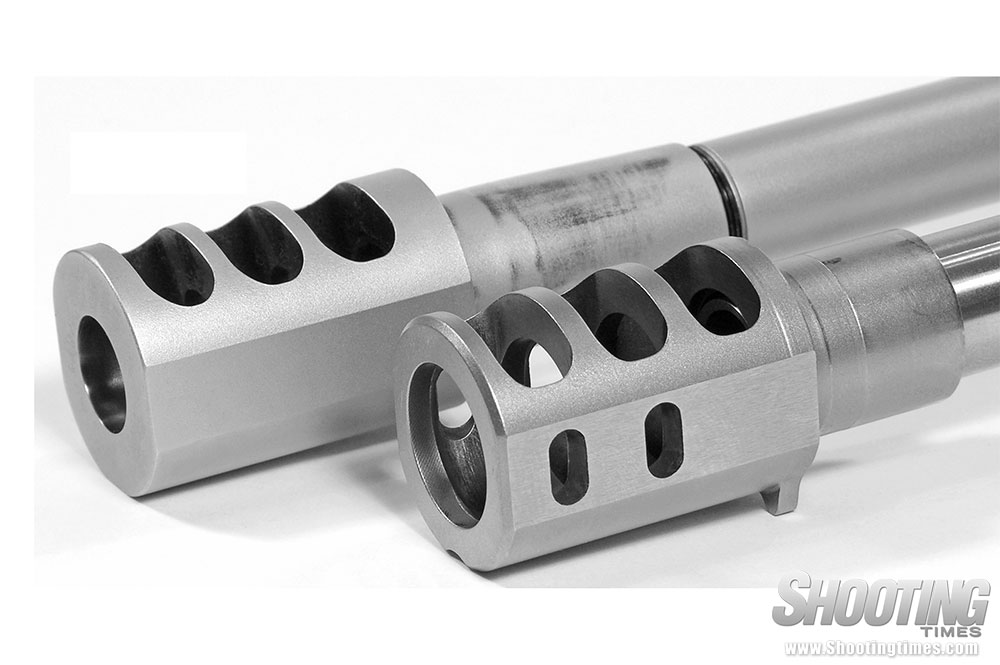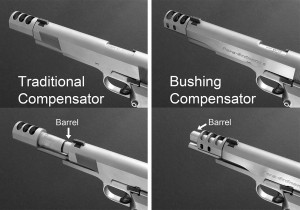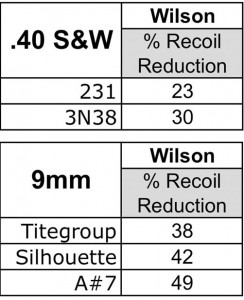 Compensators are interesting devices. They redirect gas to take the bite out of recoil and reduce muzzle rise. There are two types of compensators for semi-automatic pistols: traditional compensators and bushing compensators.
Compensators are interesting devices. They redirect gas to take the bite out of recoil and reduce muzzle rise. There are two types of compensators for semi-automatic pistols: traditional compensators and bushing compensators.

Traditional compensators attach to the barrel, while bushing compensators replace the barrel bushing and attach to the slide.
Some compensators are called bushing compensators even though they attach to the barrel via threads. They get that name because they include a traditional bushing behind the compensator, but they fall under the definition of a traditional compensator.
Bushing compensators vary by design with respect to important features. Some bushing compensators have chambers and baffles like atraditional design to help trap gas, while others don’t.
Opinions vary on how well bushing compensators work, with some suggesting that they don’t work at all because the large exit hole allows too much gas out around the bullet. Given the ambiguity of their effectiveness, I set out to compare the recoil of different compensator designs.
The main challenge when testing a bushing compensator is to determine whether it functions like a traditional design. Subjective factors often influence how we perceive recoil; perceived differences are difficult to quantify, so a mechanical method is preferred.
However, even a mechanical device can show innaccuracies when measuring recoil because of the compensator’s weight, though this should result simply in a general attenuation in recoil. A more objective criterion is to look for the gas volume effect of compensator function with multiple gunpowders.
Gas Volume Effect
A portion of the recoil force is generated from the weight of the gunpowder itself. For example, if you compare two different gunpowders that produce the same velocity but require different charge weights, the one that requires a heavier charge weight produces more recoil.
Here’s why: As gunpowder burns, it produces gas. More gunpowder weight means more gas. Gas volume contributes to the recoil force. More gunpowder weight = more gas volume = more recoil even for the same velocity.
With a non-compensated pistol, gunpowder with a higher charge weight produces more recoil and muzzle rise than a powder with a lower charge weight achieving the same velocity. Since the ports on pistol compensators vent gas upwards, that produces a reciprocal downward force that reduces muzzle rise. More gas volume upward = more downward force.
Therefore, true compensator function will reverse the gas volume effect on recoil. The higher charge weight gunpowder will generate more downward force and produce less muzzle rise than gunpowder with a lower charge weight for the same velocity.
Testing the Gas Volume Effect
Three Para Ordnance pistols were used for the test—a P14-45 in .45 ACP, a P16-40 in .40 S&W and a P18-9 in 9mm Luger.
A Wilson Combat Multi-Comp replaced the factory bushing on all three guns without modification. An Innovative Industries compensator, tested with the P14-45 pistol, also fit without modification. The P14-45 pistol had a separate Les Baer slide, fitted with a Clark .45 ACP threaded barrel using a traditional EGW cone-style compensator.
Based on published loading data, I selected gunpowders that require different charge weights for the same velocity. For the .45 ACP and 9mm loads I used Hodgdon Titegroup, Ramshot Silhouette and Accurate #7 powders. For the .40 S&W loads, I used Winchester 231 and Vihtavuori 3N38 powders.
The loads used 230-grain bullets in .45 ACP, 165-grain bullets in .40 S&W, and 115-grain bullets in the 9mm Luger. I loaded ten rounds of each caliber with two or three separate charge weights for each gunpowder.
Testing with multiple charge weights produces data that permits mathematical evaluation with linear interpolation.
Two parameters were calculated for a specified velocity: recoil (gun movement) and gunpowder charge weight. The specified, caliber-typical velocities I used were 850 feet-per-second (fps) for the .45 ACP, 1,100 fps for .40 S&W and 1180 fps for 9mm Luger.
The guns were fired from a Ransom Rest. Measuring the distance that a gun moves in the Ransom Rest indicates relative recoil. Velocity was recorded with a Shooting Chrony chronograph at approximately 10 feet. Ambient temperature was 70-80 degrees Fahrenheit.
Here is some of the data I collected from my tests:
Results
Comparing the percent of recoil reduction with the compensators shows how effective they are compared to having no compensator, and also illustrates whether or not the compensator shows the gas volume effect.

The EGW compensator reduced recoil by an average of 46-percent with the .45 ACP and showed clear evidence of the gas volume effect: gunpowders with larger charge weights had a greater reduction in recoil.
The Wilson Combat Multi-Comp reduced recoil by an average of 30-percent in the .45 ACP and showed the gas volume effect for all three calibers.
The Innovative Industries compensator produced an average of 14-percent less recoil. A gas volume effect was not obvious, however, with the Accurate #7 powder showing no greater recoil reduction than the Titegroup powder.

The Wilson Combat Multi-Comp unexpectedly produced a higher percent of recoil reduction with the 9mm Luger cartridge than the larger calibers. This seems counterintuitive, because the smaller 9mm bullet would allow even more gas to escape forward around the bullet and avoid deflection by the baffles.
It’s likely related to the lower recoil of this cartridge in general, and that the 9mm still required an average of 84-percent of the gunpowder charge weight of the .45 ACP, but with bullets half the weight. Similar gas volume with much lighter bullets might make compensator function more efficient.
Comparing other data I have from testing a traditionally-compensated .38 Super supports this idea. Its charge weights with the same gunpowders and 115-grain bullets are nearly the same as the .45 ACP with 230-grain bullets. It shows an average 74-percent reduction in recoil compared to the .45 ACP’s average 46-percent reduction in recoil. Thus, lots of gas and lighter bullets means greater recoil reduction.
Conclusion
The Wilson Combat Multi-Comp bushing compensator functions like a traditional compensator and for a surprisingly broad range of calibers, though it’s not as efficient as a conventional compensator, because it produces less recoil reduction. The Wilson’s large exit hole traps less gas for use in the ports, but it still redirects enough gas upward to help tame recoil and muzzle rise by an average of 30-percent in the .45 ACP.
The Innovative Industries compensator had a lesser effect but does show a slight reduction in recoil. Its small ports vent far less gas than the large ports of the other compensators. But the fact that it shows some reduction in gun movement makes an important point about how compensators work. Compensators reduce recoil and muzzle flip by redirecting gas. Any redirected gas creates force. The more gas they deflect, the more force they apply to counter recoil.
If you’re looking to buy a bushing compensator, check the details of their design. The ones with chambers and baffles are more effective than those without them. Baffle plates trap and redirect more gas, and compensators are all about gas.

































